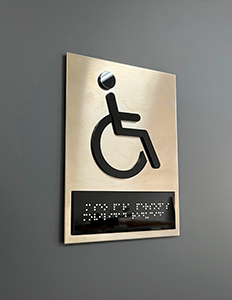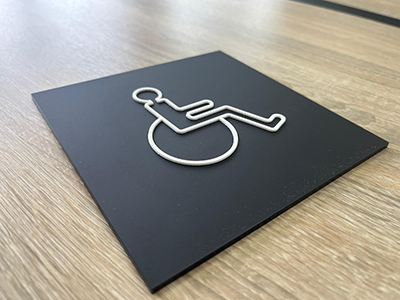Accessible Signage: Braille and Raised Relief.
Accessibility is much more than a trend—it’s a necessity that transforms the way we interact with spaces. In signage, ensuring that everyone can navigate with ease not only enhances the user experience but also reinforces a company’s commitment to inclusion and equality. From shopping centers to hospitals, more and more places recognize the importance of incorporating accessible elements into their signage.

Braille is a tactile reading and writing system designed specifically for blind or visually impaired individuals. It consists of raised dots that are read by running one’s fingers over the surface. Including braille in signage is not only a requirement in many public spaces but also an essential tool for ensuring that everyone can navigate independently. This system is commonly found on key elements such as directories, elevator buttons, and emergency signage.
Its integration demands precision: the dots must be correctly positioned, with size and spacing that meet international standards to ensure readability. While it may go unnoticed by many, for those who rely on it, braille is a tool that opens doors and breaks down barriers.
Raised lettering and tactile symbols enhance accessibility for individuals with partial visual impairment or motor difficulties. This approach ensures that text and icons are embossed, allowing them to be easily identified by touch. Often combined with braille, raised elements maximize the functionality of signage, creating an inclusive experience for a wider range of users.
The design of these signs requires a strategic approach: materials must be durable to withstand constant use, and placement must be carefully planned to ensure easy visibility and accessibility. This technical and human-centered approach not only meets accessibility regulations but also demonstrates a deep commitment to diversity and the needs of all individuals.

In short, investing in accessible signage is a way to show that a space is designed for everyone. Beyond meeting regulations, it’s an opportunity to make a difference by providing solutions that promote equality, comfort, and safety. Because a truly inclusive space doesn’t just guide, it welcomes.


